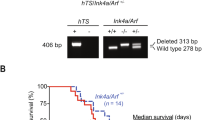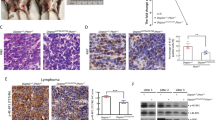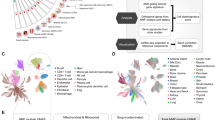Abstract
The control exerted by the INK4a/ARF locus on cellular proliferation is crucial to restrict tumor development. In agreement with this, mice with defects in this locus are highly tumor prone. However, the potential contribution of other pathways in modulating tumorigenesis in the absence of INK4a/ARF is largely unexplored. In the present study, we investigated the consequences of the combined loss of either of two cyclin-dependent kinase inhibitors, p21 and p27, in cooperation with deletion of the INK4a/ARF locus. Our results show a clear differential effect in tumorigenesis depending on the CKI that is absent. The absence of p21 produced no overt alteration of the lifespan of the INK4a/ARF-null mice, although it modified their tumor spectrum, causing a significant increase in the incidence of fibrosarcomas and the appearance of a small number of rhabdomyosarcomas. In contrast, deficiency of p27 resulted in a significant increase in lethality due to accelerated tumor development, especially in the case of T-cell lymphomas. Finally, combined deficiency of INK4a/ARF and p27 resulted in a significant increase in the number of metastatic tumors. These results demonstrate genetically the oncogenic cooperation between defects on INK4a/ARF and p27, which are common alterations in human cancer.
This is a preview of subscription content, access via your institution
Access options
Subscribe to this journal
Receive 50 print issues and online access
$259.00 per year
only $5.18 per issue
Buy this article
- Purchase on SpringerLink
- Instant access to full article PDF
Prices may be subject to local taxes which are calculated during checkout



Similar content being viewed by others
References
Adnane J, Jackson RJ, Nicosia SV, Cantor AB, Pledger WJ and Sebti SM . (2000). Oncogene, 19, 5338–5347.
Baldassarre G, Belletti B, Bruni P, Boccia A, Trapasso F, Pentimalli F, Barone MV, Chiappetta G, Vento MT, Spiezia S, Fusco A and Viglietto G . (1999). J. Clin. Invest., 104, 865–874.
Balomenos D, Martin-Caballero J, Garcia MI, Prieto I, Flores JM, Serrano M and Martinez AC . (2000). Nat. Med., 6, 171–176.
Bearss DJ, Lee RJ, Troyer DA, Pestell RG and Windle JJ . (2002). Cancer Res., 62, 2077–2084.
Brugarolas J, Bronson RT and Jacks T . (1998). J. Cell Biol., 141, 503–514.
Brugarolas J, Chandrasekaran C, Gordon JI, Beach D, Jacks T and Hannon GJ . (1995). Nature, 377, 552–557.
Carneiro C, Jiao MS, Hu M, Shaffer D, Park M, Pandolfi PP, Cordon-Cardo C and Koff A . (2003). Oncogene, 22, 361–369.
Chiarle R, Budel LM, Skolnik J, Frizzera G, Chilosi M, Corato A, Pizzolo G, Magidson J, Montagnoli A, Pagano M, Maes B, De Wolf-Peeters C and Inghirami G . (2000). Blood, 95, 619–626.
Ciaparrone M, Yamamoto H, Yao Y, Sgambato A, Cattoretti G, Tomita N, Monden T, Rotterdam H and Weinstein IB . (1998). Cancer Res., 58, 114–122.
Cipriano SC, Chen L, Burns KH, Koff A and Matzuk MM . (2001). Mol. Endocrinol., 15, 985–996.
Deng C, Zhang P, Harper JW, Elledge SJ and Leder P . (1995). Cell, 82, 675–684.
Di Cristofano A, De Acetis M, Koff A, Cordon-Cardo C and Pandolfi PP . (2001). Nat. Genet., 27, 222–224.
Erlanson M, Portin C, Linderholm B, Lindh J, Roos G and Landberg G . (1998). Blood, 92, 770–777.
Fero ML, Rivkin M, Tasch M, Porter P, Carow CE, Firpo E, Polyak K, Tsai LH, Broudy V, Perlmutter RM, Kaushansky K and Roberts JM . (1996). Cell, 85, 733–744.
Franklin DS, Godfrey VL, O'Brien DA, Deng C and Xiong Y . (2000). Mol. Cell. Biol., 20, 6147–6158.
Geisen C, Karsunky H, Yucel R and Moroy T . (2003). Oncogene, 22, 1724–1729.
Hurteau JA, Allison BM, Brutkiewicz SA, Goebl MG, Heilman DK, Bigsby RM and Harrington MA . (2001). Gynecol. Oncol., 83, 292–298.
Jackson RJ, Engelman RW, Coppola D, Cantor AB, Wharton W and Pledger WJ . (2003). Cancer Res., 63, 3021–3025.
Kiyokawa H, Kineman RD, Manova-Todorova KO, Soares VC, Hoffman ES, Ono M, Khanam D, Hayday AC, Frohman LA and Koff A . (1996). Cell, 85, 721–732.
Lebel M, Cardiff RD and Leder P . (2001). Cancer Res., 61, 1816–1819.
Liang J, Zubovitz J, Petrocelli T, Kotchetkov R, Connor MK, Han K, Lee JH, Ciarallo S, Catzavelos C, Beniston R, Franssen E and Slingerland JM . (2002). Nat. Med., 8, 1153–1160.
Lloyd RV, Erickson LA, Jin L, Kulig E, Qian X, Cheville JC and Scheithauer BW . (1999). Am. J. Pathol., 154, 313–323.
Lowe SW and Sherr CJ . (2003). Curr. Opin. Genet. Dev., 13, 77–83.
Martin-Caballero J, Flores JM, Garcia-Palencia P and Serrano M . (2001). Cancer Res., 61, 6234–6238.
Martins CP and Berns A . (2002). EMBO J., 21, 3739–3748.
Moller MB . (2000). Leukemia Lymphoma, 39, 19–27.
Morgan DO . (1997). Annu. Rev. Cell Dev. Biol., 13, 261–291.
Myung N, Kim MR, Chung IP, Kim H and Jang JJ . (2000). Cancer Lett., 153, 129–136.
Nakayama K, Ishida N, Shirane M, Inomata A, Inoue T, Shishido N, Horii I and Loh DY . (1996). Cell, 85, 707–720.
Nikitin AY, Juarez-Perez MI, Li S, Huang L and Lee WH . (1999). Proc. Natl. Acad. Sci. USA, 96, 3916–3921.
Park MS, Rosai J, Nguyen HT, Capodieci P, Cordon-Cardo C and Koff A . (1999). Proc. Natl. Acad. Sci. USA, 96, 6382–6387.
Parker SB, Eichele G, Zhang P, Rawls A, Sands AT, Bradley A, Olson EN, Harper JW and Elledge SJ . (1995). Science, 267, 1024–1027.
Philipp-Staheli J, Kim KH, Liggitt D, Gurley KE, Longton G and Kemp CJ . (2003). Oncogene, 23, 905–913.
Philipp-Staheli J, Kim KH, Payne SR, Gurley KE, Liggitt D, Longton G and Kemp CJ . (2002). Cancer Cell, 1, 355–368.
Philipp-Staheli J, Payne SR and Kemp CJ . (2001). Exp. Cell Res., 264, 148–168.
Quintanilla-Martinez L, Thieblemont C, Fend F, Kumar S, Pinyol M, Campo E, Jaffe ES and Raffeld M . (1998). Am. J. Pathol., 153, 175–182.
Ruas M and Peters G . (1998). Biochim. Biophys. Acta, 1378, F115–F177.
Sanchez-Beato M, Saez AI, Martinez-Montero JC, Sol Mateo M, Sanchez-Verde L, Villuendas R, Troncone G and Piris MA . (1997). Am. J. Pathol., 151, 151–160.
Sanchez-Beato M, Saez AI, Navas IC, Algara P, Sol Mateo M, Villuendas R, Camacho F, Sanchez-Aguilera A, Sanchez E and Piris MA . (2001). Am. J. Pathol., 159, 205–213.
Serrano M . (2000). Carcinogenesis, 21, 865–869.
Serrano M, Lee H, Chin L, Cordon-Cardo C, Beach D and DePinho RA . (1996). Cell, 85, 27–37.
Sharp R, Recio JA, Jhappan C, Otsuka T, Liu S, Yu Y, Liu W, Anver M, Navid F, Helman LJ, DePinho RA and Merlino G . (2002). Nat. Med., 8, 1276–1280.
Sherr CJ and McCormick F . (2002). Cancer Cell, 2, 103–112.
Sherr CJ and Roberts JM . (1999). Genes Dev., 13, 1501–1512.
Shin I, Yakes FM, Rojo F, Shin NY, Bakin AV, Baselga J and Arteaga CL . (2002). Nat. Med., 8, 1145–1152.
Singh SP, Lipman J, Goldman H, Ellis Jr FH, Aizenman L, Cangi MG, Signoretti S, Chiaur DS, Pagano M and Loda M . (1998). Cancer Res., 58, 1730–1735.
Slingerland J and Pagano M . (2000). J. Cell. Physiol., 183, 10–17.
Sotillo R, Dubus P, Martin J, de la Cueva E, Ortega S, Malumbres M and Barbacid M . (2001). EMBO J., 20, 6637–6647.
Topley GI, Okuyama R, Gonzales JG, Conti C and Dotto GP . (1999). Proc. Natl. Acad. Sci. USA, 96, 9089–9094.
Tsihlias J, Kapusta L and Slingerland J . (1999). Annu. Rev. Med., 50, 401–423.
Viglietto G, Motti ML, Bruni P, Melillo RM, D'Alessio A, Califano D, Vinci F, Chiappetta G, Tsichlis P, Bellacosa A, Fusco A and Santoro M . (2002). Nat. Med., 8, 1136–1144.
Wang YA, Elson A and Leder P . (1997). Proc. Natl. Acad. Sci. USA, 94, 14590–14595.
Weinberg WC, Fernandez-Salas E, Morgan DL, Shalizi A, Mirosh E, Stanulis E, Deng C, Hennings H and Yuspa SH . (1999). Cancer Res., 59, 2050–2054.
Wuarin J and Nurse P . (1996). Cell, 85, 785–787.
Yang WC, Mathew J, Velcich A, Edelmann W, Kucherlapati R, Lipkin M, Yang K and Augenlicht LH . (2001). Cancer Res., 61, 565–569.
Zhang H, Schneider J and Rosdahl I . (2002). Int. J. Oncol., 21, 43–48.
Zirbes TK, Baldus SE, Moenig SP, Nolden S, Kunze D, Shafizadeh ST, Schneider PM, Thiele J, Hoelscher AH and Dienes HP . (2000). Int. J. Cancer, 89, 14–18.
Acknowledgements
We thank Anxo Vidal for critical reading of the article and Pedro Aranda for excellent technical support with histopathology. Work at the laboratory of MS has been funded by the Spanish Ministry of Science and Technology (SAF2002-03402) and by the European Union (QLRT-2000-02084, QLRT-2000-00616 and INTACT).
Author information
Authors and Affiliations
Corresponding author
Rights and permissions
About this article
Cite this article
Martín-Caballero, J., Flores, J., García-Palencia, P. et al. Different cooperating effect of p21 or p27 deficiency in combination with INK4a/ARF deletion in mice. Oncogene 23, 8231–8237 (2004). https://doi.org/10.1038/sj.onc.1207863
Received:
Revised:
Accepted:
Published:
Issue date:
DOI: https://doi.org/10.1038/sj.onc.1207863
Keywords
This article is cited by
-
An essential role for Ink4 and Cip/Kip cell-cycle inhibitors in preventing replicative stress
Cell Death & Differentiation (2016)
-
p21 suppresses inflammation and tumorigenesis on pRB-deficient stratified epithelia
Oncogene (2014)
-
ADAR2-editing activity inhibits glioblastoma growth through the modulation of the CDC14B/Skp2/p21/p27 axis
Oncogene (2013)
-
Combined loss of p21waf1/cip1 and p27kip1 enhances tumorigenesis in mice
Laboratory Investigation (2011)
-
p21 in cancer: intricate networks and multiple activities
Nature Reviews Cancer (2009)



